Gold bugs often fear inflation and believe that gold will generally increase in price when inflation is high. But the correlation is not as simple as when inflation increases the price of gold increases. If it were, the inflation adjusted price of gold would be virtually flat. And as we can see from the chart below the red line is far from flat.
From 1913 through 1970 the “nominal price” of gold was fixed by the government and so it remained relatively stable but that didn’t mean that the purchasing power of an ounce of gold remained stable. From 1880-1914 the U.S. dollar official gold price was $20.67 per ounce. But inflation was rampant in the economy (i.e. over 90% inflation just from 1913 through 1919) so it was getting more and more difficult for the government to maintain the fiction that gold was only worth $20.67. At that price Foreign governments would have depleted the U.S. gold reserves since it would be like being able to buy gold at a discount for them.
Rather than simply repricing Gold at it’s real price and allowing the citizens to be richer, Roosevelt perpetrated one of the greatest frauds ever on the American public. He forced U.S. citizens to sell their Gold at the official price of $20.67 and once he had collected all the Gold into government coffers, then he adjusted the price to its real free market price of $35 per Troy ounce. Thus, the government made a handsome 69.33% profit in a few months (equivalent to a 69% tax on Gold owners).
Looking at the chart again we see that from 1934 through 1970 the inflation adjusted price of gold fell again. This was because even though inflation increased, the price of gold remained fixed at $35 by the government. They did this by selling all that confiscated gold to other governments at $35 per ounce thus keeping a lid on the free market price. But in 1968 despite the government selling, prices rose to $39.67 and by 1971 it had risen to $40.95 thus the free market price was 17% above the official price.
In 1971 Nixon was once again faced with the same problem as Roosevelt (but this time there was no privately held gold to confiscate). The official price of gold was so cheap that Nixon risked foreign governments buying all U.S. gold if he didn’t do something. So, he let the price float on the free market and “closed the gold window” to foreign governments (thus eliminating the necessity to sell them cheap gold) and opened the gold window to all Americans at the free market price.
So, is inflation good or bad for the price of gold?
In considering whether gold is a worthwhile investment to protect against inflation we must disregard prices prior to 1970 because the price was fixed by the government and thus it has absolutely nothing to do with the current situation.
Let’s look at prices since 1970.
Gold Prices 1970-1980
As we can see from chart #1 above, from 1970 through 1980 gold prices shot almost straight up, with a peak nominal price of $850. Prices rocketed not only in nominal terms but also in “inflation adjusted” terms. One of the problems with inflation is that it “compounds” so even seemingly small annual inflation rates add up to a significant increase in prices over the decade. Annual inflation rates were not small during the 1970’s and so over the period from 1970-1979 prices more than doubled with a total decade inflation of 103.45%. During that period gold increased from $37.40 to over $400 i.e. a more than 10-fold increase. Gold prices not only kept up with inflation but actually exceeded them by a significant margin. So, owning gold was an excellent investment and protected holders from the ravages of high inflation in the 1970’s.
On the chart below, we can see that gold averaged $37.40 in 1970 and by 1980 it averaged $672.60. While inflation went from 5.84% to 13.57%. This seeming correlation has led to the belief that gold and inflation are “joined at the hip” and always move together. But was this synchrony a rule or an anomaly due to the deregulation of gold prices?
Let’s look at some other decades to see what happened.
Gold Prices 1980-1990
During the 1980’s the price of gold once again tended to track the inflation rate as inflationary fears subsided. Inflation fell from an average of 13.57% in 1980 to 6.15% in 1982. During that same period the average price of gold fell from $672.60 to $420.75. Then as the inflation rate leveled out, so did the price of gold. From 1982 to 1991 the price of gold remained virtually the same (actually losing about $20). But even though the inflation rate was lower it was not zero, so the total inflation from 1980-1989 was still 64.41% so if you held gold for just the 1980’s you would have lost money. However, if you had held it for both the 1970 and the 1980’s you would still be ahead of inflation.
Adjusted for inflation the price of gold fell and did not protect against the slow erosion of value due to lower inflation in the 1980’s. We can see this clearly in chart #1 with the sharp decline in the inflation adjusted price of gold from 1980 through 1990.
Gold Prices 1990-2000
Inflation rates in the 1990’s continued to trend downward starting the decade at 5.39% in 1990 and averaging 1.55% in 1998 before rebounding to 3.38% in 2000. Even with fairly low annual inflation the dollar lost 1/3rd of its purchasing power. Cumulative inflation from 1990-1999 was much lower than previous decades totaling “only” 33.47% but despite that loss gold also lost value.
Gold prices averaged $411.35 in 1990 and lost roughly 29% of its value by 1998 to $293.95. And then even though inflation more than doubled from 1.55% in 1998 to 3.38% in 2000 gold prices went virtually nowhere from $293.95 in 1998 to $290.23 in 2000. So, during the 1990’s Gold was not a good store of value. However, if you had held it since 1970 you would still be ahead of inflation.
Gold Prices 2000-2010
In the first decade of the new millennium inflation started out moderate at 3.38% and hovered around there for most of the decade until the market crash in 2008 which destroyed a great deal of capital and shocked most consumers into drastically cutting expenditures thus making the average annual inflation rate go negative (deflationary) . Base on previous decades you would expect that the price would have been flat or perhaps even falling. However, that is not what happened at all. Instead Gold was once again the top performing asset class. Cumulative inflation was 28.31% from 2000 through 2009 but gold went from $290.23 to $972.35 more than tripling in price. So in this case we have neither inflation nor deregulation to account for the rapid rise in gold prices.
So, what could account for the increase? Part of the rise can be attributed to “fear”. Gold is the only asset that is not simultaneously someone else’s liability. When you own a bond, it is simply an IOU from a company or a government. The same with money in the bank. Stocks are simply pieces of paper saying that you own a portion of a company, but the company can go bankrupt. During the market crash, gold prices temporarily dipped as investors were forced to sell their gold to cover other debts. But prices quickly rebounded and as you can see from the chart below the average annual price didn’t even register the dip. Therefore, fear might account for the sharp rise in gold prices from 2008 onward but prices still went from $290 in 2000 to $695 in 2007 (i.e. prior to the crash).
There is some evidence that China and other countries were accumulating gold during this period and driving up gold prices since they recognized that at under $500 an ounce gold was an extreme bargain.
Gold Prices 2010-2018
From 2010 through 2018 inflation has been low and the economy has been in the doldrums for the majority of that period. It is possible to have both high inflation and a poor economy. This was the case during the 1970’s thus necessitating the creation of the word “stagflation“. But in this case, we had neither high inflation nor a robust economy. Total cumulative inflation for the period 2010 through 2017 was 14%. During that period gold went from $1224.53 to $1331.05 for a roughly 9% increase not quite keeping up with inflation.
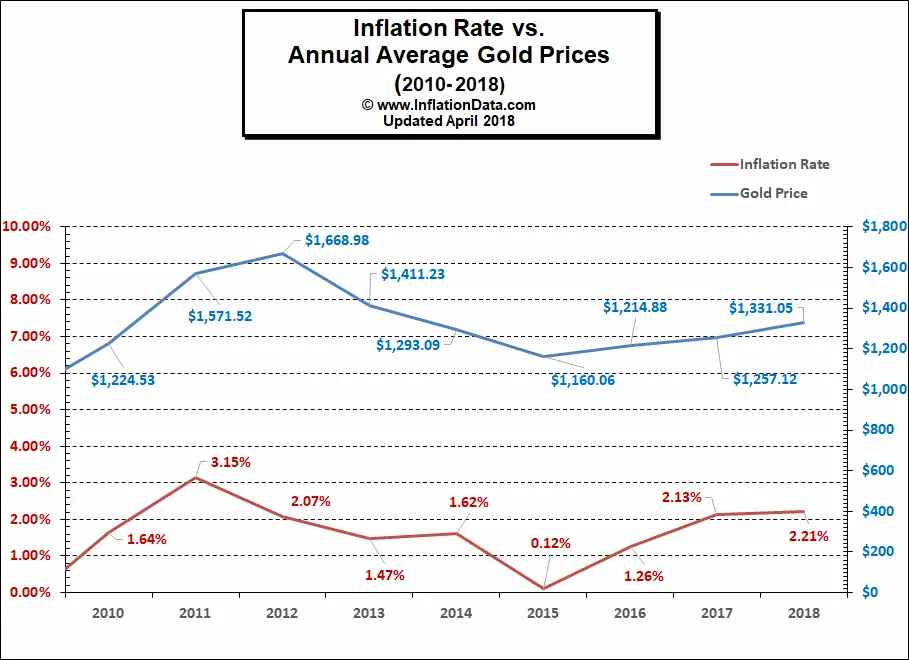 Conclusion
Conclusion
So, does gold tend to follow the inflation rate? Yes, it appears it does i.e. as the inflation rate is rising gold tends to rise and as the inflation rate is falling gold tends to fall. However, gold doesn’t always outperform the cumulative inflation over an individual decade. But it does appear to do well over longer periods of time. Often it outperforms inflation and provides a good alternative to debt based (paper) investments like stocks and bonds. A balanced portfolio of Stocks, Bonds and Gold can help reduce overall volatility in your portfolio even though at times one or the other component may be quite volatile on its own. Looking at 30-year portfolio performance from July 1971 to February 2014, the S&P 500 yielded just over 10%, while gold yielded 9.53% but a combination of the two would have had considerably less volatility, as they often move in opposite directions. Experts typically recommend that you hold 5-10% of your investable assets in some form of gold. You can easily check online for today’s price of gold to see how it compares to these historical prices.
You might also like:
- Gold is a “Crisis Hedge” not an Inflation hedge
- Oil, Petrodollars and Gold
- Comparing Oil vs. Gold
- Is There a Correlation Between Inflation and the Stock Market?
- What is the Real Inflation Adjusted Stock Price?
- Stock Market vs. Gold
- Why Buy Gold?
- The Case of the Disappearing Gold
- 2 Types of Money
- What are “Foreign Exchange Reserves”?
- Why Gold is a Good Investment for Inflationary Times
- Gold and the Federal Reserve
- Civil Liberties Rest Upon Sound Money

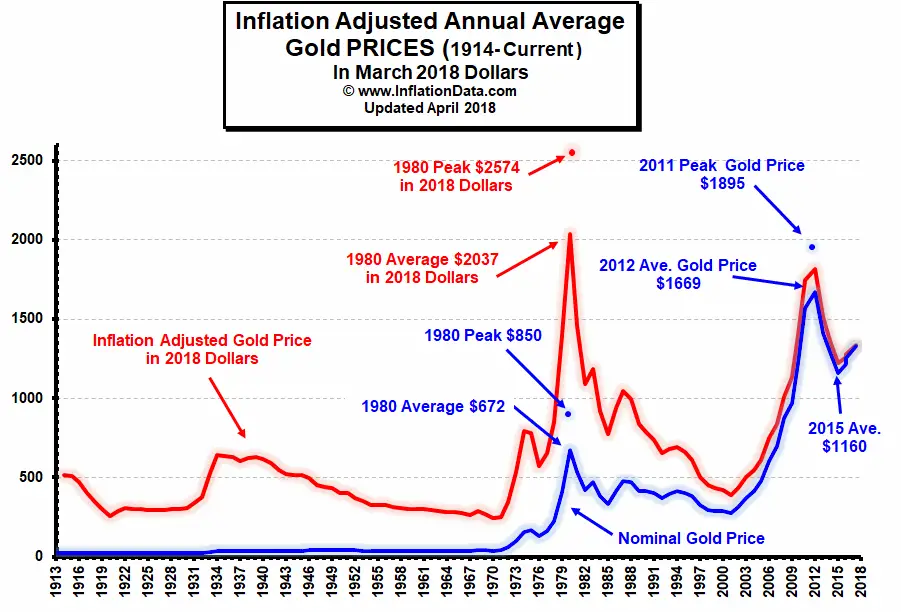
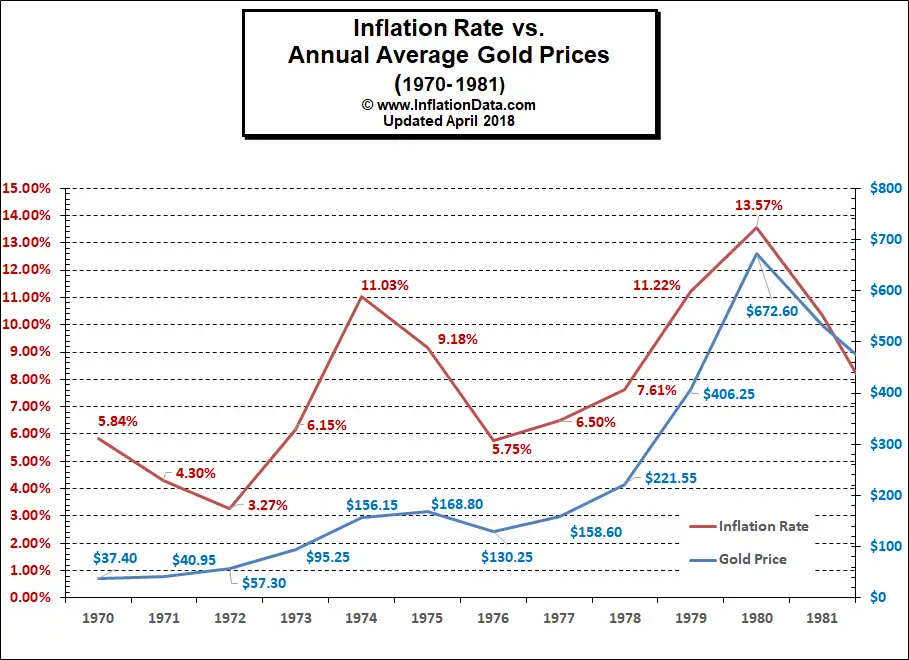
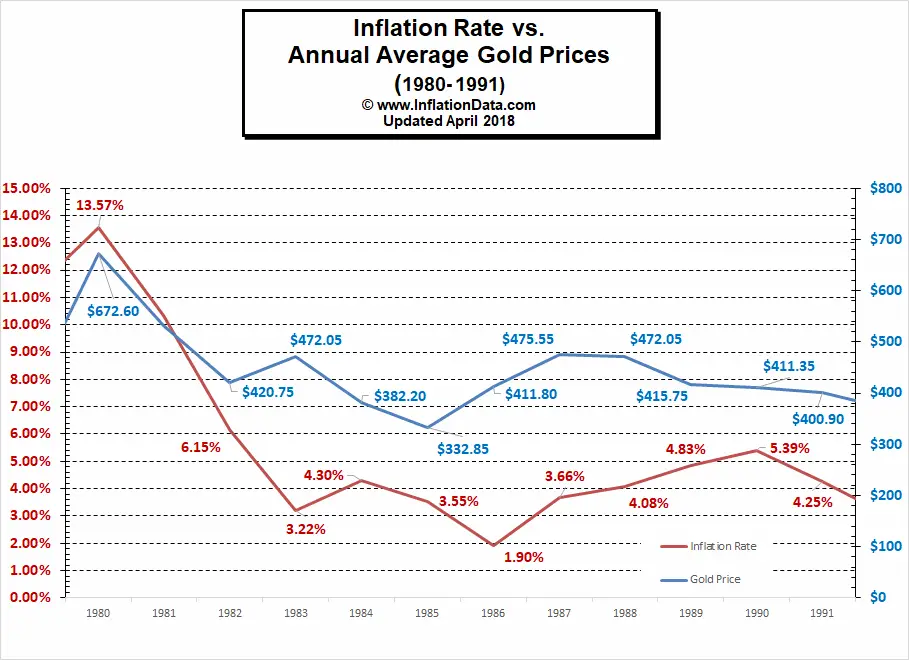
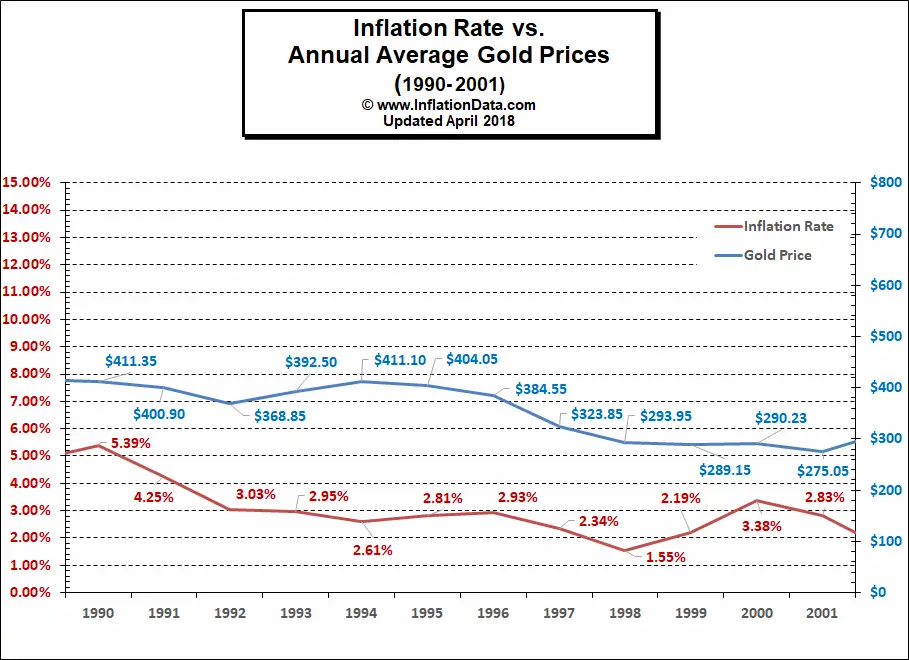
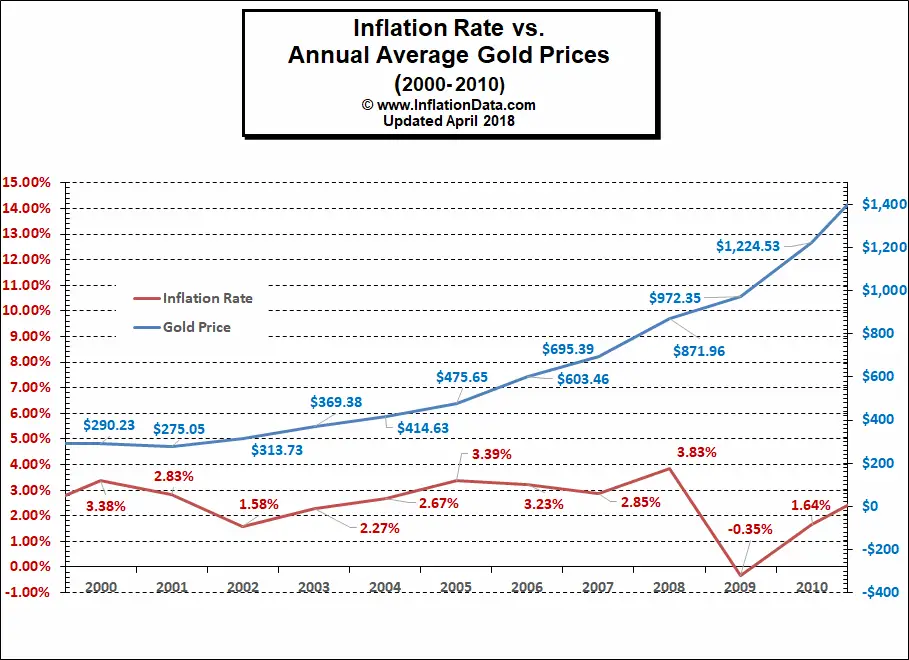
It was helpful when you mentioned that it’s typically recommended to have at least 5% of your investable assets in gold. My sister mentioned she’s interested in learning more about investing as one of her financial goals for next year. I’ll have to share this info so she can be more informed if she chooses to work with a gold seller in her area.
Inflation seems to be a major factor in determining the price of gold.
This article is full of knowledge and definitely it has helped me to acquire some important ideas that are very useful the next time I think of investing in gold.
Thank you for sharing with us!!